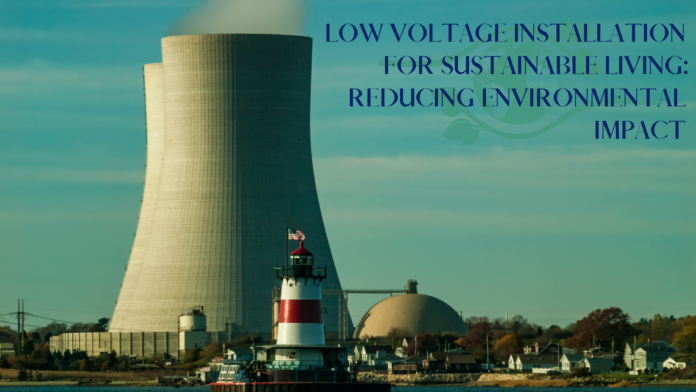The demand for sustainable and energy-efficient building solutions continues rising across residential and commercial spaces. This trend coincides with the pivotal role that electrical installations play in meeting eco-conscious goals.
After establishing the imperative of low-voltage installations, let’s delve into the tangible benefits. Not only do these systems operate below the standard mains voltage, but they also pave the way for a greener future with their energy-efficient solutions.
The Imperative of Low Voltage Installations for Sustainable Living
As climate change continues to threaten ecosystems across the planet, eco-conscious building design has become an ethical and environmental imperative. With the residential and commercial real estate sectors accounting for 36% of global energy usage and 39% of energy-related CO2 emissions, transforming construction practices is crucial. This is where low-voltage electrical systems have an invaluable role to play.
Unlike conventional systems that operate at hazardous 120-240V levels, systems utilize less than 50V to provide lighting, power, data transmission, and other functionality. This not only minimizes electrical risks but also enables radically higher levels of energy efficiency. With lower power requirements to begin with, integrating renewable sources becomes viable. The result? Drastically reduced carbon footprints for buildings.
Quality low-voltage design can decrease lighting energy usage by up to 60%, while integration with solar power or fuel cells can effectively eliminate emissions. These systems also last over twice as long as conventional electrical components, minimizing waste.
The potential for immense sustainability gains makes the widespread adoption of low-voltage installation an urgent climate goal. By choosing a reputable low voltage installation company, individuals can take significant strides toward minimizing their environmental impact while embracing a more eco-friendly and energy-efficient lifestyle.
Advantages of Low Voltage Systems
Low voltage systems achieve reductions in CO2 emissions due to lower power requirements. Quality low-voltage design can lead to lowered project costs, faster completion, and reliable systems. Other key advantages include:
- Enhanced Safety: The lower operating voltages minimize electrical hazards and risks.
- Energy Efficiency: Reduced energy usage directly correlates with lower utility bills.
- Compatibility: Low voltage systems easily integrate with renewable power sources like solar energy.
Understanding these advantages, such as the potential for CO2 emission reductions, sets the stage for exploring how we can implement these systems effectively. It’s not just about the choice of technology, but also about the strategic approach to installation.
Implementation Strategies
To successfully tap the sustainability potential of low voltage systems requires strategic approaches before, during, and after installation:
Thorough Energy Audit: A detailed audit identifies the electrical loads to be supported. This data then informs proper system design and component sizing to optimize efficiency.
Seamless Integration: Low voltage systems should interconnect seamlessly with existing electrical infrastructure. This facilitates transition without disruption while allowing conventional and low-voltage systems to complement one another.
Adherence to Best Practices: Strictly following the latest protocols and standards for low-voltage installation ensures safety, longevity, and reliability. From wiring to connections and grounding, meticulous technique is essential.
Regular Maintenance: While designed for minimal upkeep, systems must undergo regular maintenance checks. This maximizes operational life by promptly catching and addressing any issues.
Personelle Training: Many low voltage benefits depend directly on properly leveraging system capabilities. Personnel should receive extensive training to extract the full potential of new low-voltage infrastructure.
By taking a holistic approach – from audit to maintenance and training – organizations can implement low-voltage systems to their fullest sustainability potential. The climate crisis demands no less.
Success Stories
Low voltage systems have delivered tangible impacts, including:
Residential Communities: Entire neighborhoods have transitioned to low voltage, embracing energy efficiency for modern sustainable living.
Commercial Spaces: Corporations like Apple have integrated low-voltage lighting controls into their facilities, hitting ambitious sustainability targets.
Government Buildings: The Empire State Building retrofit incorporated low-voltage solutions, reducing energy usage by 40%.
Case studies highlight successful implementations, yet challenges remain. Addressing issues like coordination and technical hurdles is crucial for widespread adoption, ensuring low voltage systems transition from concept to practical solution.
Challenges and Solutions
Transitioning to low voltage does come with hurdles, but none are insurmountable:
- Misconceptions about capability can be overcome through education.
- Retrofitting older buildings may require updating electrical components to support systems.
As we look toward the future, we anticipate innovations that will further enhance the appeal of low-voltage technology. Advancements promise ever-greater efficiency and convenience.
Future Innovations
The future of low voltage includes:
- Ubiquitous lighting controls for granular, automated energy savings
- Next-generation DC appliances and devices built specially for low-voltage
- Mainstream adoption is driven by sustainable building standards and policies
The environmental impact is clear, with contributions to sustainability. But what does this mean for individuals and businesses in terms of cost? Let’s break down the financial benefits.
Cost Savings
Low voltage installations can significantly reduce expenses, including:
- Lower Energy Bills: Reduced power consumption directly lowers electricity costs by 15-40%.
- Decreased Maintenance: The exceptional durability and lifespan of low-voltage components minimize upkeep costs.
Cost savings provide a compelling reason to switch, but practicality matters. Can these systems power our daily lives? We’ll explore compatibility.
Appliance Compatibility
Most small DC appliances are made for 12V or 24V systems, particularly prevalent in solar homes. With DC-AC inverters, low-voltage systems can readily power amenities like:
- Lighting: LED lighting runs efficiently off low-voltage DC.
- Electronics: Phones, laptops, and TVs plug into standard AC outlets.
- Major Appliances: Using inverters, fridges, washers, and more can integrate into low-voltage installation.
Conclusion
As environmental consciousness and sustainability become central to how we approach construction and energy use, low-voltage electrical systems provide a pivotal path forward. Offering dramatically improved efficiency, safety, and longevity compared to conventional solutions, these technologies have proven their immense potential through real-world case studies.
Challenges and misconceptions can be overcome through education, proper implementation strategies, and a commitment to innovation. Ultimately, widely embracing low-voltage installation is an ethical and business-savvy decision – reducing our collective carbon footprint while saving money on energy and maintenance.
The climate crisis demands action, and transitioning to low voltage wherever viable is a constructive step towards equitable and ecologically sound built environments.
FAQs
What are the main environmental benefits?
Low voltage systems significantly reduce energy usage and carbon footprint. Their integration with renewable sources also facilitates cleaner power generation.
How does low-voltage installation contribute to cost savings?
The exceptional durability and lifespan of low-voltage electrical components lead to lower maintenance costs. Reduced energy usage also directly translates into 15-40% lower electricity expenses.
Can low voltage reliably power appliances in homes and offices?
Yes, with DC-AC inverters, low-voltage systems can readily power lighting, electronics, major appliances, and more, enabling modern convenience.





